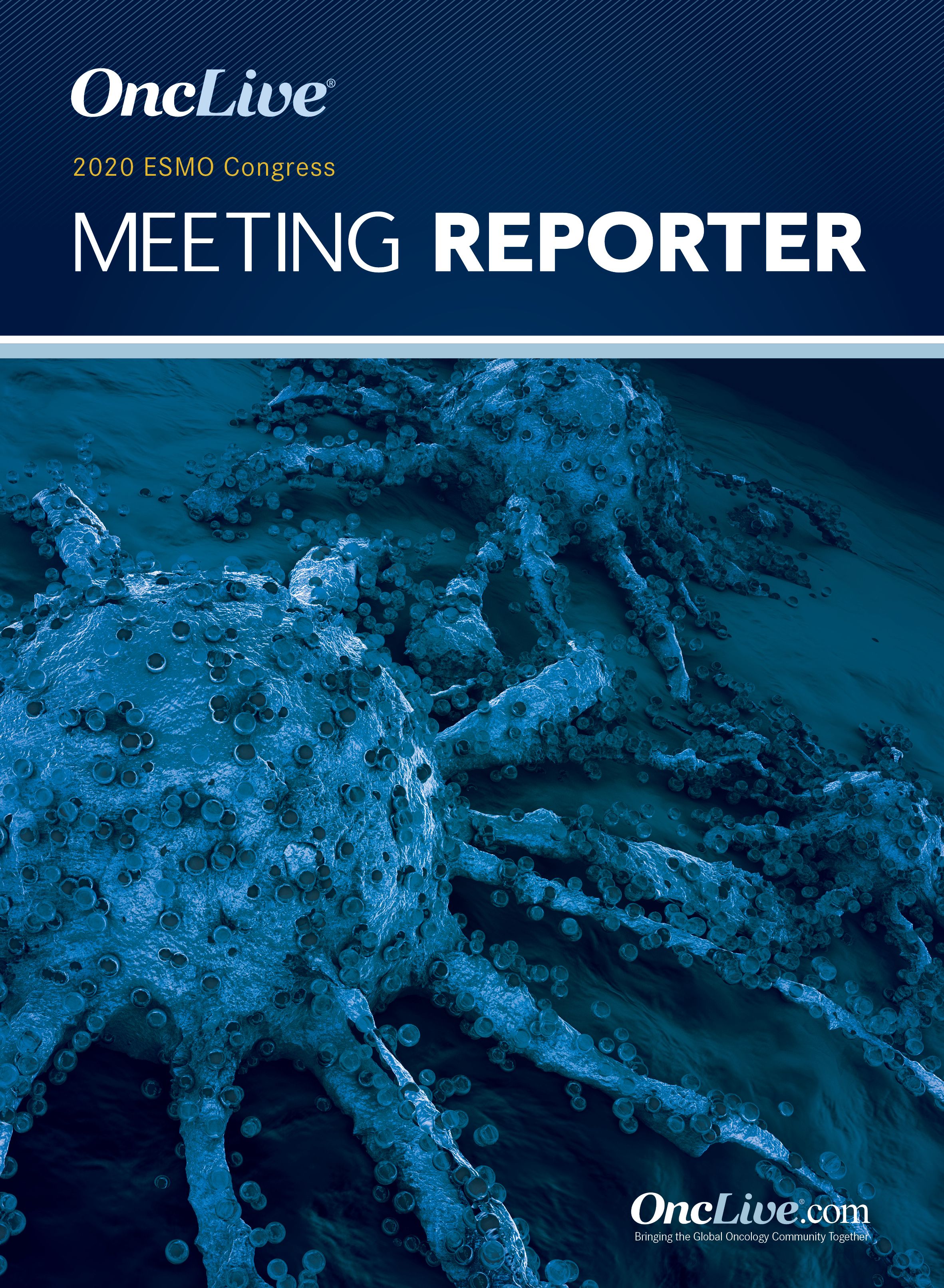Frontline Ipatasertib/Abiraterone Regimen Shows Superior Radiographic PFS in PTEN-Loss mCRPC
Ipatasertib combined with abiraterone acetate plus prednisone led to a significantly superior radiographic progression-free survival and antitumor activity compared with placebo plus abiraterone/prednisone in patients with metastatic castration-resistant prostate cancer with PTEN loss.
Johann de Bono, MD

Ipatasertib combined with abiraterone acetate (Zytiga) plus prednisone led to a significantly superior radiographic progression-free survival (rPFS) and antitumor activity compared with placebo plus abiraterone/prednisone in patients with metastatic castration-resistant prostate cancer (mCRPC) with PTEN loss, according to results of a primary analysis from the phase 3 IPATential150 trial (NCT03072238) that were presented at the 2020 ESMO Virtual Congress.1
At a median follow-up of 19 months, the median rPFS was 18.5 months (95% CI, 16.3-22.1) with the ipatasertib regimen compared with 16.5 months (95% CI, 13.9-17.0) with placebo/abiraterone (HR, 0.77; 95% CI, 0.61-0.98; P = .0335) in the PTEN-loss subgroup of patients with mCRPC. The estimated 1-year event-free rates were 64.4% and 63.3%, respectively.
In the intent-to-treat (ITT) population, the median rPFS was 19.2 months (95% CI, 16.5-22.3) with the investigational regimen compared with 16.6 months (95% CI, 15.6-19.1) with the control regimen, leading to a 16% reduction in the risk of radiographic disease progression or death (HR, 0.84; 95% CI, 0.71-0.99; P = .0431), which did not meet the prespecified end point of superiority. The 1-year event-free rates in the ITT population were 65.3% and 63.0%, respectively.
Ipatasertib was also associated with improved prostate-specific antigen (PSA) progression and PSA response rates.
“Combined androgen receptor (AR) and AKT blockade with ipatasertib plus abiraterone improves clinical outcomes over AR blockade with abiraterone alone for [patients with] PTEN-loss mCRPC, a poor-prognosis subset,” lead study author Johann de Bono, MD, Regius Professor of Cancer Research, and a professor in Experimental Cancer Medicine at The Institute of Cancer Research and The Royal Marsden NHS Foundation Trust, said in a virtual presentation during the meeting.
Forty to 50% of patients with mCRPC have loss in PTEN, which is associated with worse prognosis and reduced benefit from AR blockade. Reciprocal cross talk has been demonstrated between AR and PI3K/AKT signaling, as AR blockade can activate PI3K/AKT signaling and enable prostate cancer cell survival.
Ipatasertib is an oral, investigational, potent small molecule that binds to the ATP-binding pocket of all 3 isoforms of AKT; the agent inhibits AKT serine-threonine kinase activity and has been shown to improve antitumor activity of AR blockade in preclinical prostate cancer models.
Previously, phase 2 data of ipatasertib and abiraterone showed prolonged rPFS versus abiraterone alone, with the greatest benefit reported among patients with PTEN-loss tumors.2
In the phase 3 IPATential150 study, investigators sought to evaluate the efficacy and safety of ipatasertib plus abiraterone/prednisone in 1101 patients with asymptomatic or mildly symptomatic previously untreated mCRPC. Patients were randomized 1:1 to receive ipatasertib at 400 mg daily plus abiraterone at 1000 mg daily, along with prednisone at 5 mg twice daily, or placebo plus abiraterone/prednisone until radiographically assessed disease progression.
Patients were stratified by tumor PTEN loss by immunohistochemistry (IHC), prior docetaxel in the hormone-sensitive disease setting, progression by PSA, presence of liver/lung metastases, and geographic region.
The co-primary end points of the trial were investigator-assessed rPFS via Prostate Cancer Working Group 3 criteria in the ITT population and PTEN-loss by IHC populations. Secondary end points included OS, time to pain progression, time to initiation of chemotherapy, objective response rate, and investigator-assessed rPFS in the PTEN-loss population. There was statistical testing hierarchy via rPFS in the PTEN loss by IHC (α = .05), rPFS in the ITT population (α = .01), OS in the PTEN loss by IHC population (α = .05 or .04), and OS in the ITT population (α = .05 or .04).
The baseline characteristics were well balanced between the 2 arms, and also between both the ITT population (n = 1101) and the PTEN-loss subgroup (n = 521). Overall, the median age was 69.5 years, and 69.2% of patients were white. A total 17.9% of patients had previously received a taxane, and about half of patients had a PSA-only progression factor. Most patients had site of metastatic disease in the bone (84.2%), followed by the lymph nodes (39.1%), lung or liver (11.9%), and other (6.5%).
A total 377 patients on the placebo/abiraterone arm were still on the study compared with 367 on the ipatasertib arm, with 33% and 36%, respectively, were on treatment. In the placebo arm, 177 patients discontinued the study compared with 180 on the ipatasertib arm, with 25% of placebo-treated patients and 22% of ipatasertib-treated patients discontinuing due to death.
The rPFS benefit extended to patients with an ECOG performance status of 0 (HR, 0.76), who were at least 75 years old (HR, 0.67), with lactate dehydrogenase levels that are the upper limit of normal and higher (HR, 0.77), did not have prior taxane-based treatments (HR, 0.74), PSA-only progression and other progression factors (HR, 0.77, both), and the presence of liver/lung metastases (HR, 0.66).
rPFS was also measured in a PTEN-loss population defined by next-generation sequencing (NGS; n = 208). Here, the median rPFS was 19.1 months with ipatasertib compared with 14.2 months with placebo (HR, 0.65; 95% CI, 0.45-0.95; P = .0206).
In the PTEN-loss subgroup, the confirmed ORR was 61% with ipatasertib/abiraterone, with a 19% complete response (CR) rate and a 41% partial response (PR) rate; these rates in the placebo arm were 39%, 6%, and 32%, respectively. The median duration of response (DOR) was 17.7 months (95% CI, 14.0–not estimable) with ipatasertib and 13.9 months (95% CI, 12.1-18.0) with placebo.
In the ITT population, the ipatasertib ORR was 61%, with an 18% CR rate and a 43% PR rate; the placebo/abiraterone arm experienced a 44% ORR, a 9% CR rate, and a 34% PR rate. The median DOR was 15.9 months with ipatasertib compared with 16.2 months with placebo.
The PSA response rates were 84% and 72% with ipatasertib and placebo, respectively, in the PTEN-loss subgroup (P = .0012). In the ITT population, the PSA response rates were 81% and 76%, respectively (P = .0183). Additionally, time to PSA progression favored the ipatasertib arms in both the PTEN-loss subgroup (HR, 0.69; 95% CI, 0.55-0.87; P = .0013) and the ITT population (HR, 0.73; 95% CI, 0.62-0.85; P <.0001).
Moreover, the time to pain progression was improved with the addition of ipatasertib in the PTEN-loss subgroup (HR, 0.77) and the ITT population (HR, 0.87). The time to initiation of cytotoxic chemotherapy was also prolonged with ipatasertib in those with PTEN loss (HR, 0.84) and in the ITT population (HR, 0.80).
OS remains immature with this dataset, de Bono explained, but an early trend shows survival favoring the ipatasertib arm in the PTEN-loss group (HR, 0.91) and ITT population (HR, 0.93).
Regarding safety, grade 3/4 and 5 adverse effects (AEs) were higher with ipatasertib (70.1% and 4.4%, respectively) versus placebo (39.0% and 3.7%). Serious AEs in the experimental and placebo arms were 39.6% and 22.7%, respectively. Additionally, more patients on ipatasertib versus placebo discontinued treatment (21.1% vs 5.1%) and had dose reductions (39.9% vs 6.2%). Grade 3/4 AEs with ipatasertib reported more than 2% than with placebo included rash, diarrhea, hyperglycemia, increased alanine aminotransferase, increased aspartate aminotransferase, and dehydration.
In an effort to mitigate drug discontinuations, de Bono said the institution of prophylactic loperamide and antihistamines can manage diarrhea and cutaneous AEs, respectively.
References
1. de Bono JS, Bracarda S, Sternberg CN, et al. IPATential150: efficacy and safety from the phase III study of ipatasertib plus abiraterone vs placebo plus abiraterone in metastatic castration-resistant prostate cancer. Presented at: 2020 ESMO Virtual Congress; September 19-21, 2020; Virtual. Abstract LBA4.
2. de Bono JS, de Giorgi U, Rodrigues DN, et al. Randomized phase II study evaluating Akt blockade with ipatasertib, in combination with abiraterone, in patients with metastatic prostate cancer with and without PTEN loss. Clin Cancer Res. 2019;25(3).doi:10.1158/1078-0432.CCR-18-0981




